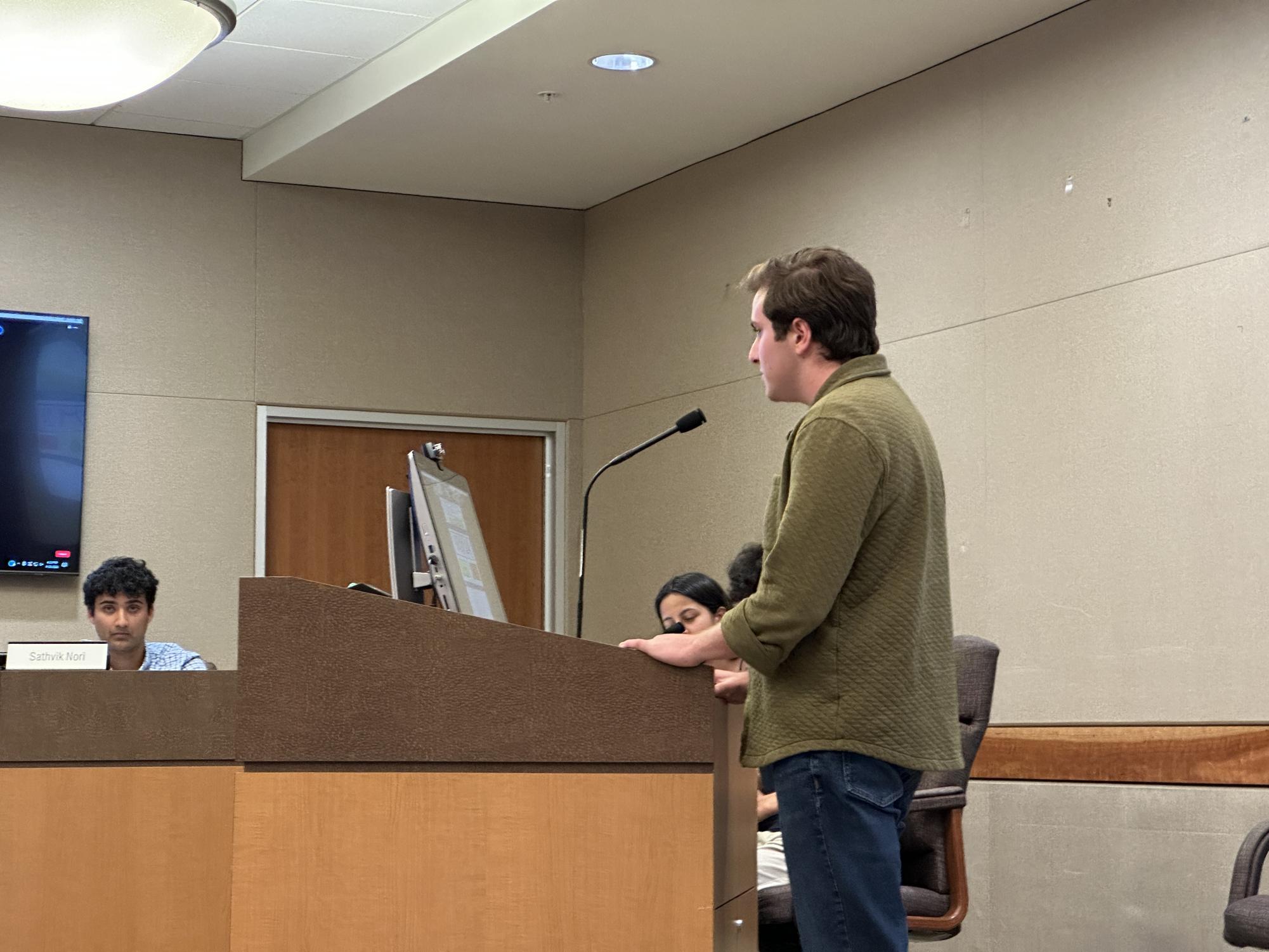The elimination of honors classes: Equity or imbalance?

In a decade where affirmative action is at the forefront of solutions to establish equality, public schools have begun delving into the discussion of how to decrease the equity gap existing between different social classes.
Since 2016 the Sequoia Union High School District (SUHSD) has been working to streamline courses to create a more diverse learning environment. However, these actions have been met with backlash as many members of the district feel they are not being involved in the decision-making process.
Jacob Yuryev, a student trustee on the district board, believes it is imperative that all district decisions be made with input from everyone involved.
“This removal of honors classes was not a decision made while taking community input into account,” Yuryev said. “This decision was made by administrators without input from the community.”
This removal of honors classes was not a decision made while taking community input into account. This decision was made by administrators without input from the community.
— Jacob Yuryev
Citizens of the California public school system have long debated whether honors classes perpetuate an equity gap between different ethnic groups and whether this causes inequalities for disadvantaged students.
One of the proposed solutions for this equity gap involves detracking, where schools would streamline courses and group all students together in one class.
Proponents of this solution believe that teaching all students at the same level would rectify disadvantages currently experienced by particular groups ensuring all pupils have the same opportunities to take Advanced Placement (AP) classes in high school, and ensuring the completion of all A-G requirements for the UC college system.
In an overview of a study conducted by SUHSD, administrators explain the benefits of removing honors classes.
“It has long been a goal of the California Department of Education and the Sequoia Union High School District (SUHSD) to have more students obtain A-G credit and AP/IB credit, thereby demonstrating a greater percentage of students’ readiness for the postsecondary experiences of college and career,” the study said.
However, opponents of this system believe this would be a step back for advanced learners and would restrict opportunities for students wishing to take classes such as calculus during high school.
Marcus Oettinger, a senior at Carlmont who spoke at the Sept. 20 board meeting on the detracking of honors classes, believes students who are interested in a specific subject should have opportunities to pursue that interest in more rigorous classes. Additionally, students at an academically advanced level deserve to be challenged through advanced classes. By providing classes for all levels of learning, he believes that all students can excel.
“My parents came to America because it was a place of opportunity to excel. The only way for them to excel is to go to Menlo or Crystal Springs or Sacred Heart or any of the other private schools that have these honors courses and drive their students to succeed at a high level,” Oettinger said.
My parents came to America because it was a place of opportunity to excel. The only way for them to excel is to go to Menlo or Crystal Springs or Sacred Heart or any of the other private schools that have these honors courses and drive their students to succeed at a high level.
— Marcus Oettinger
SUHSD would not be the first district in the state to detrack classes. In 2015, the San Francisco Unified School District (SFUSD) removed accelerated math classes at the middle and high school levels. The current system in SFUSD reflects these changes and groups students together for ninth and 10th-grade math classes, after which they may take classes according to their academic abilities.
SFUSD supported their actions with data showing a 32% drop in repeat rates for Algebra 1, according to Tom Loveless. However, a parent group called Families for San Francisco analyzed the district’s data and concluded that misleading and unsupported statistics were being portrayed.
They determined detracking did not influence student performance in the way the district was presenting and that it could not be determined whether the new system was actually helping or hurting students, according to Loveless.
Despite these findings, high schools across the state continue to implement detracking measures in an effort to close the controversial equity gap. Some of these schools include Patrick Henry High School in San Diego and Culver City High School in Culver City.
Many members of the district believe SUHSD’s proposed method of streamlining course offerings will create an environment in which students who previously struggled to obtain A-G credits would have more opportunities. They said it would also benefit students who hadn’t yet started on the “advanced” track by freshman year. The intended result would be higher graduation and college enrollment rates.
In the past 10 years, the district has already made certain changes to available classes. For example, in 2019, the district removed Advanced Integrated Science for incoming 9th graders and instead enrolled all freshmen in biology. Additionally, in 2016, Carlmont combined the AS chemistry and chemistry courses into a single course.
“Our district mission is to engage and prepare all students to excel in a global society. A detracked heterogeneous class does exactly that by exposing students to a more diverse classroom community, preparing them for that global community,” said Erin Walsh, an English teacher at Menlo Atherton, at the Sept. 20 board meeting.
Our district mission is to engage and prepare all students to excel in a global society. A detracked heterogeneous class does exactly that by exposing students to a more diverse classroom community, preparing them for that global community.
— Erin Walsh
The district study reviewed data collected based on these changes in course offerings to determine whether changes benefited academic performance and created a more equitable school environment. It study concluded that students who have access to more rigorous coursework are more likely to meet high-level expectations. Socio-economically disadvantaged students were shown to have better academic performance and, therefore an easier time meeting graduation requirements after course changes were made.
“When students have access to rigorous coursework and high standards, they rise to meet those expectations,” said Gina Sudaria, the superintendent for the Ravenswood School District. “The success of disadvantaged students doesn’t diminish opportunities for others. Passing rates for students who are not socioeconomically disadvantaged remain steady, and access to challenging programs like advanced placement and international baccalaureate courses has expanded.”
While many school administrators believe district-wide implementation of streamlining courses is necessary, some believe that it should be up to each school to determine the best solution for their students.
I think the board should leave the determination of what courses are offered at different school sites to the schools. It would be very frustrating for me, as a school leader, to want to go in a certain direction with Carlmont and to have that move be thwarted by the district.
— Gay Buckland-Murray
Carlmont Principal Gay Buckland-Murray believes that streamlining courses is an action that should be taken, given the data presented by the study. However, as she feels comfortable with the current courses offered at Carlmont, she believes it should be up to the discretion of each school to decide which course best fits their student population.
“I think the board should leave the determination of what courses are offered at different school sites to the schools. It would be very frustrating for me, as a school leader, to want to go in a certain direction with Carlmont and to have that move be thwarted by the district,” Buckland-Murray said.
“My role and job as student trustee is to accurately represent the student’s voice. From my interactions and talking to students school district-wide, I have seen that a majority of students support bringing back the advanced and honors classes that the school district has already removed,” Yuryev said.
Those against the removal of honors classes argue that grouping all students together in common core classes creates an environment where students are unable to excel. Students at the Sept. 20 board meeting argued more diverse classrooms create less rigorous learning environments.
Students agreed that there is an issue of equity in the public school system. However, Oettinger said that removing honors classes does not address the root of the problem and will not create a long-lasting solution.
“The intention of the district, the intention of the teachers that support the initiative, it’s good; nobody’s doubting that,” Oettinger said. “I think the focus should be to meet every student where they are and help students that may not be at grade level get to grade level, and students that are at grade level or exceeding grade level should be allowed to foster that and continue to grow.”
When analyzing the district study, Yuryev found it presented false conclusions. He said the claim that student grades rose after courses were removed is false, and these rises in grades were due to “grade inflation.”
In his review, Yuryev concluded that the study‘s data “could not be used to establish a causal relationship because of the multitude of variables involved and as a result should not be used as an argument for or against detracking.”
Students First is a district-wide group developed as a way to ensure student and parent perspectives are being taken into account during district decision-making. Their mission, as stated on their website, is to “lift the voices of SUHSD students and parents.”
“We are kind of an ad hoc group of parents who coalesce around issues that we feel need to be addressed with the school board and the site leadership,” said Linda McGeever, a member of Students First.
Their efforts regarding honors classes began in March of last year when they sent a letter to the school board voicing their concerns about the removal of honors classes. Despite claims by the board that the new system was benefiting students, members of Students First wanted to look at the data, so they requested an analysis by the district.
“We said, ‘let’s look at the data. You’ve had a year two years under your belt. Let’s see what it’s doing, and if it’s achieving the objectives.’ We asked the board to intervene and request that analysis,” McGeever said.
The study concluded that the removal of honors and AS classes had improved grades and pass rates. They found that streamlining classes aided in more rigorous classes, which helped students meet expectations.
“The results of this study, shared in more detail in each of the Executive Summaries, as well as the longer narrative below, suggest that when students have greater access to rigorous coursework and are held to high standards, they are more likely to meet those expectations,” the study said.
However, Students First found the study to be flawed. The study was conducted by administrators who were already in favor of detracking, leading to a biased and cherry-picked conclusion, according to McGeever.
While members of Students First don’t agree with the method the board is using to address the equity gap, they agree that a solution is necessary.
They believe the equity gap should be addressed in elementary and middle schools rather than waiting until high school when the gap between students has already increased. Additionally, McGeever noted that she feels the board is misinterpreting equality to mean equity and is providing the wrong solution for the current problem.
“Giving each student what they need is equity – different students need different opportunities to grow,” McGeever said. “Elimination of honors is more equality where each student is limited to the exact same opportunities with the hopes it will change outcomes later – and it’s not. It doesn’t make logical sense. Our district doesn’t have an agreed upon definition of equity. If they did, perhaps this could help fuel better ideas to solve the equity issue along with appropriate alignment and implementation of those ideas.”



